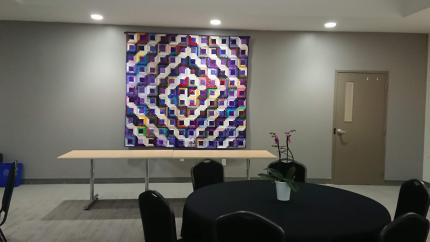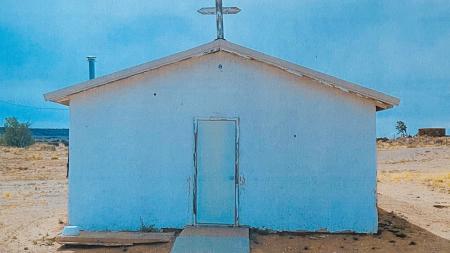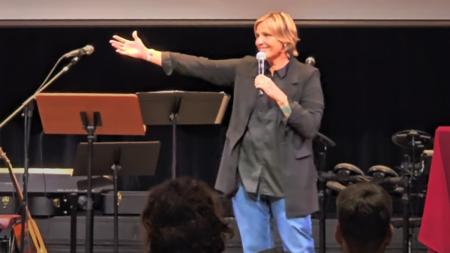Diversity and Unity Reflected in a Quilt

As the Canadian staff of the Christian Reformed Church in North America prepared for reopening their newly renovated office space in Burlington, Ont., they wondered what they could hang on the walls to best capture the mission, vision, values, and work of the entire denomination. The answer, in part, came in the form of a quilt.
The initial idea for a quilt came from Dean Heetderks, art director for The Banner, the denomination’s magazine.
“The variety of shapes and fabrics of a quilt beautifully reflect the diversity of the Christian Reformed Church in North America,” Heetderks said. “The texture and warmth of the quilt also convey the welcome the Christian Reformed Church strives to offer.”
CRCNA staff soon put a request out on Facebook to see if a quilter somewhere might have a blanket to donate. One woman who saw that post contacted us, and a new idea was born.
“This would be a great project to do with a bunch of quilters across Canada,” wrote Sheila Van Der Linden from Edmonton, Alta. “I would be willing to coordinate it. I would write up instructions for a block and get quilters from across Canada to send me blocks. I can assemble and quilt it.”
And that’s just what she did. The idea was offered to all CRC people across the United States and Canada. More than 65 contributors responded by sending at least one block.
From the notes included with the blocks, we know that these quilt squares represent at least 45 Christian Reformed congregations from Colorado to New York to British Columbia to Nova Scotia.
“To be a part of a project like this is humbling. I hope that it exceeds your expectations. It did mine,” said Van Der Linden after sending in the finished blanket.
All quilters were asked to use the same “log cabin” template for their squares, and they were welcome to use whatever fabrics they wanted, with one exception. This would allow Van Der Linden to stitch the individual squares into a finished quilt that reflected both unity and diversity.
Traditionally, the center block of this template is done in red to represent the heart of a home. Van Der Linden asked quilters to use purple for that part instead.
“I chose purple to be in the center because it is a royal color, and I wanted this quilt to honor the King of kings. I also chose to have the center square larger than the strips around it, because he is greater than us,” she said.
The finished quilt measures about 7.5 feet (2.3 meters) wide. The constant presence of purple holds all of the squares together, and there is great diversity in the rest.
“I did not take any blocks apart. It was not important to me if the seams were slightly crooked, or the size a little off. It was important that the block was included as it came to me. So each seam in this quilt, each stitch, I can honestly say, was made with love. And each person who contributed did so to honor the King of kings with their gift,” said Van Der Linden.
The final product is beautiful. Van Der Linden noted that the stories behind the blanket are even more meaningful.
“The most amazing thing about this quilt is the beauty that is not visible — such as the little notes written to tell us about the gratefulness of the person who was able to sew a block, and how the carefully chosen fabrics had a story.”
Some of those stories came from remote congregations who appreciated the chance to participate in a full denominational effort.
One note, for example, came from Burdett, Alta:
“Here are three blocks from Burdett Christian Reformed Church. We’re just a small prairie church built in 1911 and amazingly still worship there. God is GREAT!” it said.
Another came from Long Island, N.Y.:
“These squares are from Christ Community Church in East Islip,” it said. “We are the only Christian Reformed church on Long Island. God’s blessings as you stitch this wonderful example of the diversity of our churches. It was a wonderful night of fellowship for us.”
Other notes offered an explanation about why certain fabrics were selected.
“I included colors our church uses during the liturgical year — they are also found in a set of stained-glass windows our church commissioned several years ago,” wrote a contributor from Holt, Mich. “The butterfly [in the fabric] reminds me of the year our sanctuary was decorated with butterflies on Easter Sunday as a symbol of resurrection and transformation.”
A square from Winchester, Ont., included this note: “Have fun. I know I did. I chose these colors. Pink = caring and compassion. Red = the blood of Jesus. Blue = the heavenly realm. Green = growing and fruitful.”
A contributor from Grand Rapids, Mich., explained, “The material I used is left over from a Lone Star quilt I made for my granddaughter who is a freshman at Calvin.”
The most distinctive square on the quilt is found at the center. It was made by women at the Indigenous Family Centre (IFC), a CRCNA ministry in Winnipeg, Man. In addition to the purple at its center, this square also include a beaded medicine wheel.
“Our square utilizes the four colors (red, white, black, and yellow) that are symbolic of the four directions, the four seasons of creation, the four seasons in life, and the four sacred medicines (first plants) given to us by Creator,” wrote Michelle Visser-Wikkerink, director of IFC.
“The circle beaded in the center is a medicine wheel that depicts the number 4 bound up in one. The medicine wheel is a symbol of harmony, understanding, and perfection. When we are commanded to love the Lord our God with all our heart, soul, mind, and strength, these are the ideas that are symbolized in the medicine wheel.”
This contribution from IFC was especially meaningful because the idea of hanging a quilt in the CRC Canadian office had raised some red flags with some CRCNA staff members from Indigenous backgrounds. A summary of these concerns and an explanation about the center block from IFC is now hanging next to the quilt:
When the CRCNA first had the idea of creating a quilt for this space, we found out that quilted blankets can signify colonialism and oppression to some Indigenous people.
In many parts of North America, for example, it was white colonists who first introduced quilting to Indigenous people. These new, quilted blankets were needed because traditional sources of warmth — such as buffalo or bison hide — were no longer available after herds were wiped out during white settlement.
In later years, quilts and other European-style blankets were also distributed to Indigenous children after they had been forced from their homes and sent to residential schools. While given with good intentions, these gifted blankets were a reminder to children that a new culture was being pushed upon them.
With this in mind, we wanted to acknowledge this painful history and also honour Indigenous people with our quilt.
Van Der Linden finished the quilt on time for it to be presented during the grand reopening celebrations on Nov. 6. She noted that a few blocks are still arriving at her place in Edmonton. She plans to wait for the last of them to arrive and will then make a companion piece to be hung elsewhere in the building.
“What I especially love about this quilt is that it is a product of the combined efforts of people in the local church — and how it produces such a showpiece of beauty in this building,” said Canadian ministries director, Darren Roorda. “It reminds us all, again and again, of the great things God can do through the combined efforts of Christian people in our churches.”


